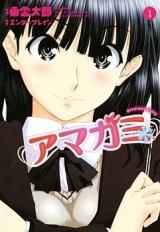INTRODUCTION
Amagami, Kimikiss and LovePlus are the trinity of eroge/visual novels which got their manga adaptations from mid-late 2000s. For some reason (probably nostalgia) I decided to revisit Amagami and - oh boy, was I pleasantly surprised with its' quality!
THE SUBGENRE
The manga adaptations of eroge all follow the same pattern; they have multiple arcs, each dedicated to a single "path" to getting together with a particular girl. Arcs themselves are not in chronological order nor connected and should be seen as separate stories in "what if" choices the male lead decides to pursue.
REVIEW
I will be honest; back in late 2000s I thought they were pretty much low-quality manga, but re-reading this, I discovered gold.
Ofcourse, it's all matter of perspective. When I say Amagami aged well and gotten better, I mean this in context of more recent manga adaptations of VNs (or following the same POV recipe).
In recent years we see this genre become more and more imbalanced with male protagonists becoming annoyingly and deliberately bland, and romance becoming more and more unreasonable and escapist. This has ruined the overall quality of the medium and storytelling.
Re-reading this from 2020 perspective (post-"Why are you here sensei?" post-Getsuyoubi no Tawawa" post-"Gambare Douki-chan" and the rest with eyeless bland protagonists and pathetic story-line), I cant but admire the characteristics of this manga.
CHARACTERS: MALE LEAD
Characters are well written and I was particularly surprised with the main lead, Yunichi Tachibana (yes, I remember the name of a romcom protagonist) who is an actual character, with EYES and face, his own personality!
Sure, he is no stuff of legend like Tomoki or Kazuma, but he also not an eyeless cartboard cutout or a loser buttmonkey (like Kentaro or whatever from Love Hina) and is definitely his own character.
He is helpful and sweet (selfless helping is his trait), and while he does give into the girls demands, but he never rolls over nor simps for the girl (I'm looking at you Cuckzuya). He is also a healthy boy; he is considered a "pervert" (albeit a gentlemanly one), he has normal reactions and isn't a bottom feeder type of character (like Otaku characters in later otaku-yankee gyaru subgenre), he isnt a loser and does take initiative and action when needed.
All this puts the reader in a comfortable position, as he has trust that the MC is reasonably capable of dealing with developments as the story progresses. There are no cheap attempts to connect him with target audience through making him a simp, loser, otaku etc (you name it), but rather he is a normal, innocent and gentle highschooler from a good family.
He is also smart enough to find solutions and offer insights into girls' problems, being an actual asset which makes it even more believable why they'd fall for him.
He also, on a few occasions demonstrates bravery, perseverance and ability to flip the script on a girl when when put in a disadvantaged situation.
This is more than can be expected from your regular romcom protagonist these days.
And all this is seamlessly woven into the character and you might not be able to note it unless you re-read.
GIRLS CAST
The girls cast is varied and can be divided into:
- athletic and aloof kouhai
- innocent, shy and curvy kouhai
- "perfect" class president with a lot of internal stress and identity issues
- silly „princess-type“ senpai beauty.
- forceful and wild „bad friend“
so there's enough variety for different tastes. I'ts also important to note is that this manga has good plot elements; each girl has her own troubles, fears and issues, and overcomes them - with support from MC - over course of the story arc. There are often moments of despair but the overall healthy plot setting prevents any major drama to ruin the innocent high school romance feel. Girls, their motivations, position, and thoughts are well written, well paced, etc. i admit that i didn't get all the subtleties back then, but i did now.
For example in the first arc, reading it way back i always thought the girl was a bit unhinged and crazy. But she isn't, and her motivation for acting this way is result of pressure of trying to be perfect while developing a suppressed shadow persona. Her background and character are actually believable and her journey to reconcile with herself and accept herself is an endearing part of the arc. These aspects of the plot outgrow the „just romance“ manga and make the manga believable, sweet and a bit painful. For example, if one went through this in real life and then broke up with the girl later, one would probably always remember such a time with a sense of warmth perhaps mixed with a bit of sadness.
ARTWORK
The art is as nostalgic (to me) as is warm and detailed.
it captures well the youthful slice of life when the protagonists feel in the air that there is "something" afloat, but they still are busy with school and life. It's rather painful but mostly very, very sweet to read.
The artist paid attention to drawing, and I must admit, kissing scenes are pretty hot. This being a clean manga from 2000s (pre-Love-Ru), there is SOME fanservice, but there are no sex scenes nor anything you would consider distasteful like obvious over the top fanservice (like in „To Love Ru“ or „Why are you here sensei?“) or really anything, degenerate, debauched not perverted.
It's a manga you can legit keep on the bookshelf in your living room and not be ashamed if your grandma opens it.
OVERALL: WORTH RE-READING
I imagine history will judge many subsequent romantic manga in a much more (deservedly) negative light.
however, I expect Amagami to be rediscovered and enter it's rightful place among low-key classics of romance manga.
(Note: this is a re-post of my FB comment from a few years back. Here it will be more useful.)





